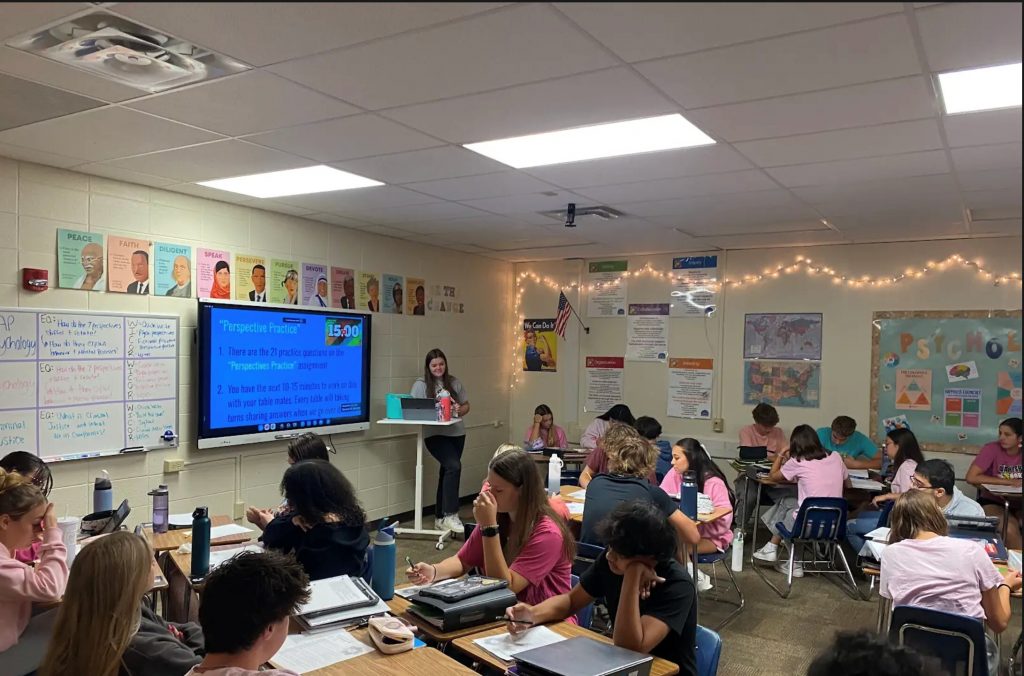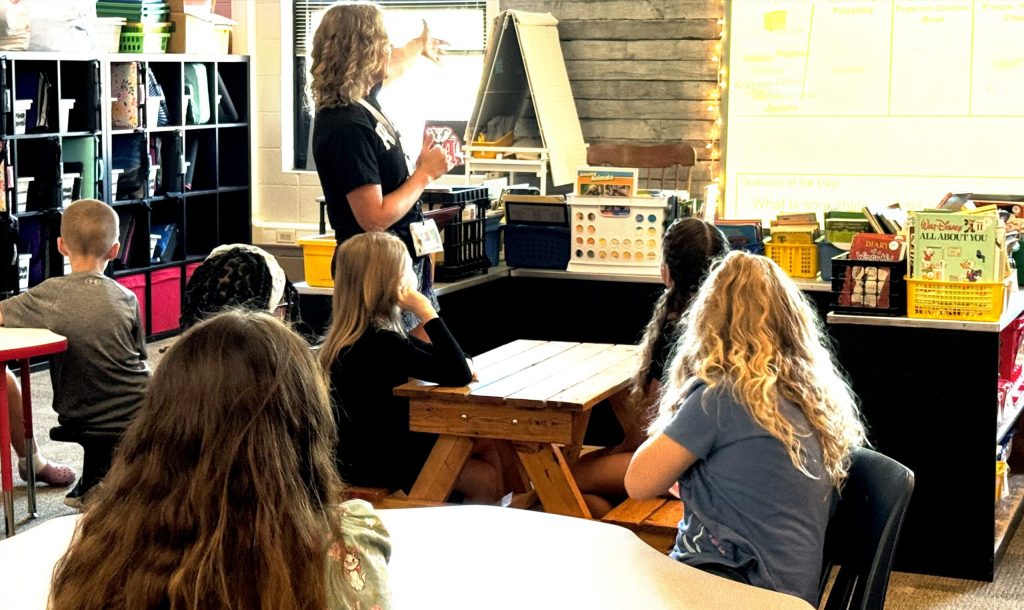Wisconsin Students Still Lag Behind in Math, Reading Since Pandemic
Months behind in math, a half-grade behind in reading compared to 2019, study finds.

Social Studies teacher Samantha Zak at Waukesha North High School monitors students working together in groups before sharing their answers with classmates. Photo courtesy of the Waukesha School District
Average student achievement in Wisconsin remains months behind in math, and a half-grade behind in reading compared to learning levels in 2019.
That’s according to the latest Education Recovery Score Card at the Center for Education Policy Research at Harvard University.
In Wisconsin, 83 percent of students are in districts whose average math achievement in 2024 remained below their own 2019 levels, according to the research done at Harvard and Stanford universities.
The average student in some districts, such as West Allis-West Milwaukee School District, remains a full grade level or more below their 2019 mean achievement in math.
Reading remains a concern across Wisconsin, with 94 percent of students in districts with average reading achievement below 2019 levels, according to the scorecard.
“Unless state and local leaders step up now, the achievement losses will be the longest lasting — and most inequitable — legacy of the pandemic,” Tom Kane, a professor from Harvard University who led the study, said in a statement.
The Wisconsin Legislature passed a bipartisan law last year to change how the state’s youngest students are taught to read.
The law, known as Act 20, moved students to a phonics-based model known as “the science of reading” beginning this school year, but the results have not yet been realized in many districts.

A teacher at Prairie Elementary School in Waukesha reviews classroom expectations with students during the first week of classes. Photo courtesy of the Waukesha School District
Waukesha, Fond du Lac bright spots for learning recovery
But there are two bright spots in the state: Waukesha and Fond du Lac school districts.
The School District of Waukesha has nearly recovered to 2019 levels in both reading and math. And some districts such as Fond du Lac School District are now scoring above their 2019 means in math.
Since 2021, Fond du Lac has used pandemic relief funds to improve the curriculum and provide professional development opportunities for educators, said Superintendent Jeffrey Fleig.
“The decisions we have made in the past four years — based on principle, purpose, and policy rather than pain, pressure, or politics — have resulted in more growth than any other district in our state,” he said.
From 2022 to 2024, Fond du Lac showed the greatest improvement in math scores out of the 20 largest school districts in the state, surpassing pre-pandemic math levels.
The district also had one of the highest positive changes in math achievement in the entire state of Wisconsin.
Fond du Lac experienced the highest positive change in reading growth in all Wisconsin school districts from 2022 to 2024.
“There have been a lot of conversations in our district recently, and while opinions may differ, one thing is very clear: our students are growing and achieving more than ever before,” Fleig said.
Wisconsin received $2.4 billion in federal pandemic relief for K-12 schools — or roughly $2,800 per student.
While that’s less than the national average of $3,700 per student, the money did contribute to academic recovery in some districts.
In Waukesha, the school district invested more than $6 million on curriculum and training since the pandemic.
Jenn Gennerman, deputy superintendent of teaching of learning, said all elementary, middle and high schools were moved to “common learning” experiences.
For example, if a second grader on the north side of Waukesha is learning to decode words and diagram vowel patterns, a second grader on the south side of the city is learning the same thing, at the same time.
The consistency has improved reading scores across the district, Gennerman said.
“We are ensuring that we are getting research-based sound curriculum resources, and then the next step is professional development,” Gennerman said. “So the value is in getting high quality resources with great educators and instructional practices. It’s just a benefit when we’re all on the common pacing, because then we can help professionally develop our educators.”
Wisconsin students still lagging months behind in math, reading following pandemic was originally published by Wisconsin Public Radio.
If you think stories like this are important, become a member of Urban Milwaukee and help support real, independent journalism. Plus you get some cool added benefits.


















Wisconsin school districts have been getting “research based, sound curriculum resources” for the last three decades and not much has changed in terms of school achievement. If a school district is making exceptional progress, why isn’t DPI sending out staff to document what is being done and making this known to the public. When most any test scores are reported, school districts with families that have high incomes most always score better than those districts with family incomes that are lower. Why haven’t
any of the educational researchers looked at why this happens?????
Phonics is an evidence-based, best practice approach.
Reading is foundational to all subjects and s a life long skill.
Children will gain confidence and perform better across the board. Graduation rates will increase.
I leaned to read with Phonics 65 years ago. I attribute life long learning to Phonics.
I agree with Mingus. . .
Does anyone care?
The former MPS Superintendent made more than $300,000 a year, and our students are behind in reading and math.
If scores do not improve, there should be something in the contract—your salary is reduced. You get a bonus for improvement.
MPS Student Ranking: A False Binary.
The Dunning Krueger Effect:
“You don’t know what you don’t know”. Political Bias, White Privilege & Anti-Milwaukee sentiment are often apparent in replies.
Of course high income families have better educational outcomes and schools are optimal funded. Home ownership creates stability. Children don’t have high levels high levels of stressors.
Research Acute Childhood Experiences. If a child scores 4 on a scale of 10 their life will be adversely impacted.
Conversely, low income families have lower educational outcomes. Low home ownership, lack stability and poorly funded schools. Higher Suspension rate of boys.
Including, not limited to Historic Segregation, Deindustrialization, lack of Investment, lack of Opportunities, Off-shoring Manufacturing Jobs,
Act 10, Minimum Wage, Mass Incarceration.
Standardized tests ONLY test how well students are able to take a standardized test on the day of testing. NCLB has been one of the worst “educational reforms” in the last century! This is particularly the case in K-12 students. More and more colleges and universities are forgoing the use of standardized test scores in the admission process. The use of performance portfolios is a far better indicator of future success.
So the state of Wisconsin cannot seem to improve student achievement across the board. Children from upper income families do better because they are less likely to have experienced trauma, hunger, homelessness, violence in their daily lives. Children from low-income families do experience the trauma of hunger, homelessness, under funded schools, and crime/violence. Research tells us that trauma impacts students ability to learn. Maslow’s Hierarchy of Needs tells us that humans must meet their basic survival needs before they have the capacity to achieve higher needs such as learning. To put it succinctly, poverty impacts students ability to learn.
It we are serious about improving students’ test scores, we need to address the conditions of poverty e.g. access to healthy and nutritious food, safe and secure housing, clean appropriate clothing. Minnesota significantly improved student tests scores across the board by providing free breakfast and lunch for every student.
The legislative “reforms” do little to impact student scores because they don’t address the root cause of poor student achievement. Mandating the use of phonics to the exclusion of all other methods; state wide ban of cell phones in the classroom; or teaching cursive, does little–except scoring political points–to impact test scores. To do that, the legislature needs to accept the extension of Medicaid funds, increase funding to schools in low income communities; address the food deserts throughout the state–food deserts are not just an urban problem. The worst food desert in Wisconsin is Waushara County, the most rural of all counties; fund more counselors and mental health professionals in schools in low income communities; raise teacher pay, which will help ease the teacher shortage that Act 10 created; etc. Unfortunately, the Wisconsin legislature is dominated by RRRs (radical reactionary republicans) who believe the only handouts government should make are to the uber wealthy.